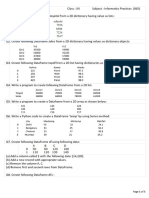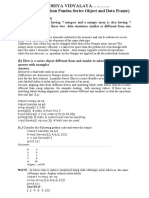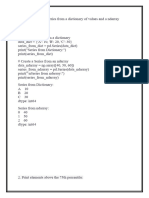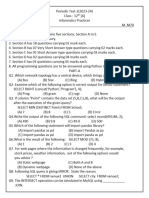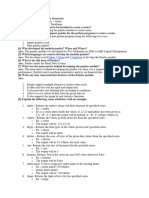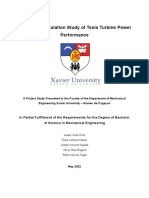0 ratings0% found this document useful (0 votes)
2 viewsAssignment-1 (Series in Python).PDF.crdownload
The document contains a series of questions and programming tasks related to the Pandas library in Python, specifically focusing on creating and manipulating Series objects. Each question requires the application of Pandas functions to achieve specific outcomes, such as creating Series, performing arithmetic operations, and modifying values. The tasks are designed for students in Class XII studying Informatics Practices.
Uploaded by
pahwamanvi14Copyright
© © All Rights Reserved
Available Formats
Download as PDF, TXT or read online on Scribd
0 ratings0% found this document useful (0 votes)
2 viewsAssignment-1 (Series in Python).PDF.crdownload
The document contains a series of questions and programming tasks related to the Pandas library in Python, specifically focusing on creating and manipulating Series objects. Each question requires the application of Pandas functions to achieve specific outcomes, such as creating Series, performing arithmetic operations, and modifying values. The tasks are designed for students in Class XII studying Informatics Practices.
Uploaded by
pahwamanvi14Copyright
© © All Rights Reserved
Available Formats
Download as PDF, TXT or read online on Scribd
You are on page 1/ 10
ARAVALI INTERNATIONAL SCHOOL
Assignment-01, Class- XII, Subject: IP
QUESTIONS BASED ON PANDAS SERIES
Questions Solutions
Q.1- Given the following Series1
A 100
B 200
C 300
D 400
E 500
Write the command to create above Series and
then double the value in series and store in
another series named Series2
Q.2- State whether True or False
a. A series object is size mutable.
b. A Dataframe object is value mutable
Q.3- Consider a given Series , Series1:
200 700
201 700
202 700
203 700
204 700
Write a program in Python Pandas to create the
series and display it.
Q.4- Consider the following Series object, s
IP 95
Physics 89
Chemistry 92
Math 95
i. Write the Python syntax which will display
only IP.
ii. Write the Python syntax to increase marks
of all subjects by 10.
Q.5- Consider a given series : SQTR
QTR1 50000
QTR2 65890
QTR3 56780
QTR4 89000
QTR5 77900
Write a program in Python Pandas to create and
display the series.
Q.6- What will be the output produced by the
following programming statements 1 & 2?
import pandas as pd
S1=pd.Series(data=[31,41,51])
print(S1>40) -->Statement1
print(S1[S1>40]) -->Statement2
Q.7- Given two series S1 and S2
S1 S2
A 39 A 10
B 41 B 10
C 42 D 10
D 44 F 10
Find the output for following python pandas
statements?
a. S1[ : 2]*100
b. S1 * S2
c. S2[ : : -1]*10
Q.8- Given the following Series S1 and S2:
S1 S2
A 10 A 5
B 20 B 4
C 30 C 6
D 40 D 8
Write the command to find the multiplication of
series S1 and S2
Q.9- Consider a given Series , Subject:
ENGLISH 75
HINDI 78
MATHS 82
SCIENCE 86
Write a program in Python Pandas to create this
series
Q.10- Consider the following Series object, “company”
and its profit in Crores
TCS 350
Reliance 200
L&T 800
Wipro 150
i. Write the command which will display the
name of the company having profit>250.
ii. Write the command to name the series as
Profit.
Q.11- Consider two objects a and b.
a is a list whereas b is a Series. Both have values
10,20,25,50.
What will be the output of the following two
statements considering that the above objects
have been created already
a. print(a*2) b. print(b*2)
Justify your answer.
Q.12- Given a Pandas series called Sample, the
command which will display the last 3 rows
is .
a. print(Sample.tail(3))
b. print(Sample.Tail(3))
c. print(Sample.tails(3)
d. print(Sample.Tails(3))
Q.13- What will be the output of the following
code?
import pandas as pd
s = pd.Series(6,index=range(0,5))
print(s)
Q.14- If series s1 is having following data,
What would be the result of the command
print(s1[3:6])?
Q.15- What will be the output of the following
code?
import pandas as pd
import numpy as np
s = pd.Series(np.arange(10,50,10))
print(s)
print (s.ndim)
print(s.shape)
print(len(s))
Q.16- Write a program to create a Series having
10 random numbers in the range of 10 and
20
Q.17- Consider the following Series ‘s’-
0 4.0
1 5.0
2 7.0
3 NaN
4 1.0
5 10.0
dtype: float64
(i) Write a Python code to add 1 to all the
elements.
(ii) Write a code to replace all NaN with 0.
Q.18- Predict the output of the following code.
import pandas as pd
import numpy as np
data = {'one':'a','two':'b','three':'c'}
s=pd.Series(data)
print(s)
print(s.size)
Q.19- Create a Series object S1 using a python
sequence [2,4,6,8] and default indices.
Q.20- Write the output of the following code fragment.
import pandas as pd
s2=pd.Series(["i","am", "a","student"])
print(s2)
QUESTIONS BASED ON PANDAS SERIES ( Part-2)
Q.21- Write the output of the following code fragment.
import pandas as pd
s1=pd.Series(200,index=range(2,13,2))
print(s1)
Q.22- Write the output of the following code fragment.
import pandas as pd
s1=pd.Series(range(2,11,2), index=[x for x in
"abcde"])
print(s1)
Q.23- Write the output of the following code fragment.
import pandas as pd
import numpy as np
x=np.arange(10,15)
s3=pd.Series(index=x, data=x*2)
s4=pd.Series(x**2,x)
print(s3)
print(s4)
Q.24- Sequences section and contribution store the
section name ( 'A','B','C','D','E') and contribution
(8900,8700,7800,6500,nil) for charity. Your
school has decided to donate more contribution
by each section, so donation has been doubled.
Write code to create series object that stores the
contribution amount as the values and section
name as indexes with data type as float32.
Q.25- Write the output of the following code fragment.
import pandas as pd
import numpy as np
val1=np.arange(5.25,50,10.25)
ser1=pd.Series(val1,index=['a','b','a','a','b'])
print(ser1)
print(ser1['a'])
print(ser1['b'])
Q.26- Consider a series object s10 that stores the
number of students in each section of class 12 as
shown below. First two sections have been given
task for selling tickets @ Rs.100/- per ticket as a
part of social experiment. Write code to create
the series and display how much section A and B
have collected.
A 39
B 31
C 32
D 34
E 35
Q.27- Consider the series s4 as given below
0 2.50
1 17.45
2 20.25
3 87.25
4 33.76
What will be the output after executing the
following:
S4[0]=1.75
S4[2:4]= -23.74
print(S4)
Q.28- Consider the following code-
import pandas
s1=pandas.Series([2,3,4,5,6],index=['a','b','c','d','e'])
s1[1:5:2]=345.6
s1[2:4]= -14.65
print(s1)
What will be the output after executing the code.
Q.29- Consider the Series object s12 that stores the
contribution of each section, as shown below:
A 6700
B 8000
C 5400
D 3400
Write code to modify the amount of section 'A'
as 8800 and for section 'C' and 'D' as 7700. Print
the changed object.
Q.30 A Series object trainingdata consists of 2000
rows of data. Write a program to print (i) First
100 rows of data (ii) Last 5 rows of data
Q.31- Consider the following Series s3-
a 1.5
b 3.0
c 4.5
d 6.0
e 7.5
Now create the above series and find the output
of the following commands-
i) print(s3+3) ii) print(s3*2)
iii) print(s3>3.0) iv) print(s3[s3>3.0])
Q.32- Consider the Series object s12 that stores the
contribution of each section, as shown below:
A 6700
B 8000
C 5400
D 3400
Write code to create the series and display those
sections that made the contribution more than
Rs. 5600/-
Q.33- Number of students in class 11 and 12 in three
streams( 'Science', 'Commerce' and 'Humanities')
are stored in two series objects c11 and c12.
write code to find total number of students in
class 11 and 12 , stream wise.
Q.34- Consider the series s1 and s2 and s3-
S1 S2 S3
0 10 0 5 a 3
1 20 1 10 b 6
2 30 2 15 c 9
3 40 3 20 d 10
4 50 4 25 e 11
5 30
6 35
Now find the output of the following-
i) print(S1+S2)
ii) print(S1*S3)
iii) print(S1-S2)
Q.35- Consider the Series object s12 that stores the
contribution of each section, as shown below:
D 6700
A 8000
B 5400
C 3400
i) Write code to create the series and display all
its values sorted in descending order.
ii) Write code to display all its indices sorted in
ascending order.
Q.36 Given a Series object shown below:
A 6700
B 8000
C 5400
D 3400
dtype : int64
Why is following code producing error while
working on Series object s13?
import pandas as pd
s13.index=range(0,5)
print(s13)
Q.37 What will be the output of the following
program:
import pandas as pd
first=[7,8,9]
second=pd.Series(first)
s1=pd.Series(data=first*2)
s2=pd.Series(data=second*2)
print("Series1:")
print(s1)
print("Series2:")
print(s2)
Q.38 What is the output of the following program:
import pandas as pd
import numpy as np
data=np.array(['Mon','Tue','Wed','Thu','Fri','Sat','
Sun'])
s=pd.Series(data)
print(s[:4])
print(s[-4:])
Q.39 What is the output of the following program:
import pandas as pd
import numpy as np
data=np.array(['Mon','Tue','Wed','Thu','Fri','Sat','
Sun'])
s=pd.Series(data, index=[101,102,103,104,105,
106,107])
print(s[[103,105,107]])
Q.40 What will be the output of the following:
import pandas as pd
D={'a':10,'b':11,'c':12}
S=pd.Series(D,index=['b','c','d','a'])
print(S)
You might also like
- Super 40 - Pandas Series Worksheet 1 - AnswersNo ratings yetSuper 40 - Pandas Series Worksheet 1 - Answers10 pages
- Data Handling using pandas - I Q & ANS (1)No ratings yetData Handling using pandas - I Q & ANS (1)9 pages
- Class 12th QuestionBank InformaticsPracticesNo ratings yetClass 12th QuestionBank InformaticsPractices148 pages
- Assignment-1 (Python Pandas-Series Object and Data Frame: 1. Answer The Following100% (1)Assignment-1 (Python Pandas-Series Object and Data Frame: 1. Answer The Following8 pages
- DATA%20HANDLING%20AND%20CSV%202024-%202025No ratings yetDATA%20HANDLING%20AND%20CSV%202024-%2020253 pages
- Subject: Informatics Practices (Code-065) Class - XIINo ratings yetSubject: Informatics Practices (Code-065) Class - XII11 pages
- Database First vs. Code-First Approach in Software Design WorkflowsNo ratings yetDatabase First vs. Code-First Approach in Software Design Workflows3 pages
- Sip Connect Technical Recommendation v11No ratings yetSip Connect Technical Recommendation v1145 pages
- JIT Techniques Practiced in Service IndustryNo ratings yetJIT Techniques Practiced in Service Industry4 pages
- Luvimar Fire Control Avenue: Rizal Gatuslao ST., Bacolod City Tel. No. 034-476-1566, 708-6185No ratings yetLuvimar Fire Control Avenue: Rizal Gatuslao ST., Bacolod City Tel. No. 034-476-1566, 708-61859 pages
- Application For Registration of Worker'S Association (Was)67% (6)Application For Registration of Worker'S Association (Was)1 page
- Insert Paper Title Here in Title Case (Style: CET Title) : Chemical EngineeringNo ratings yetInsert Paper Title Here in Title Case (Style: CET Title) : Chemical Engineering3 pages
- The Transition of Croatian Seaports Into Smart Ports - MIPRO 2019 Saša AksentijevićNo ratings yetThe Transition of Croatian Seaports Into Smart Ports - MIPRO 2019 Saša Aksentijević5 pages
- Nikon_NR-5500_Auto-Refractometer_Repair_ManualNo ratings yetNikon_NR-5500_Auto-Refractometer_Repair_Manual25 pages
- Visual Studio - Why Am I Getting - Cannot Connect To Server - A Network-Related or Instance-Specific Error - Stack OverflowNo ratings yetVisual Studio - Why Am I Getting - Cannot Connect To Server - A Network-Related or Instance-Specific Error - Stack Overflow25 pages
- scaled-agile-safe-product-owner-product-manager-popm-6.0-dumps-by-cox-27-05-2024-11qa-certscareNo ratings yetscaled-agile-safe-product-owner-product-manager-popm-6.0-dumps-by-cox-27-05-2024-11qa-certscare12 pages
- Fish Fin Turbine - CruzNasolOpallaRaguroTagle - Updated Paper 1 2 1No ratings yetFish Fin Turbine - CruzNasolOpallaRaguroTagle - Updated Paper 1 2 167 pages
- Assignment-1 (Python Pandas-Series Object and Data Frame: 1. Answer The FollowingAssignment-1 (Python Pandas-Series Object and Data Frame: 1. Answer The Following
- Subject: Informatics Practices (Code-065) Class - XIISubject: Informatics Practices (Code-065) Class - XII
- Database First vs. Code-First Approach in Software Design WorkflowsDatabase First vs. Code-First Approach in Software Design Workflows
- Luvimar Fire Control Avenue: Rizal Gatuslao ST., Bacolod City Tel. No. 034-476-1566, 708-6185Luvimar Fire Control Avenue: Rizal Gatuslao ST., Bacolod City Tel. No. 034-476-1566, 708-6185
- Application For Registration of Worker'S Association (Was)Application For Registration of Worker'S Association (Was)
- Insert Paper Title Here in Title Case (Style: CET Title) : Chemical EngineeringInsert Paper Title Here in Title Case (Style: CET Title) : Chemical Engineering
- The Transition of Croatian Seaports Into Smart Ports - MIPRO 2019 Saša AksentijevićThe Transition of Croatian Seaports Into Smart Ports - MIPRO 2019 Saša Aksentijević
- Visual Studio - Why Am I Getting - Cannot Connect To Server - A Network-Related or Instance-Specific Error - Stack OverflowVisual Studio - Why Am I Getting - Cannot Connect To Server - A Network-Related or Instance-Specific Error - Stack Overflow
- scaled-agile-safe-product-owner-product-manager-popm-6.0-dumps-by-cox-27-05-2024-11qa-certscarescaled-agile-safe-product-owner-product-manager-popm-6.0-dumps-by-cox-27-05-2024-11qa-certscare
- Fish Fin Turbine - CruzNasolOpallaRaguroTagle - Updated Paper 1 2 1Fish Fin Turbine - CruzNasolOpallaRaguroTagle - Updated Paper 1 2 1



























